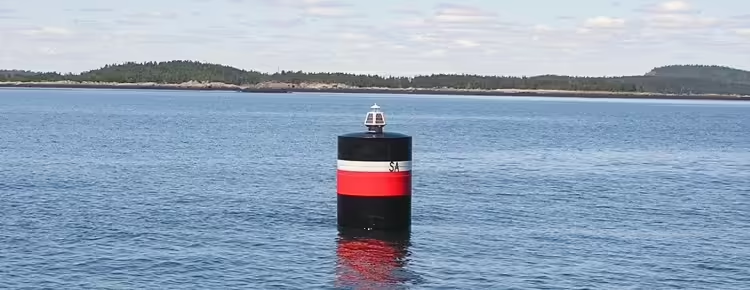Whether you are a veteran mariner navigating a large vessel or a novice mariner navigating a sail boat, one area of expertise that you must share is in the knowledge of marine aids to navigation. Buoys, marine lanterns, daymarks and other land based structures are all part of a larger integrated network of AtoN, designed to make navigation on the water safe for all involved.
In this article, we’ll list the most common buoys you’ll encounter in North American waterways. We’ve used the Canadian Coast Guard’s Canadian Aids to Navigation System (2011) as a guide.
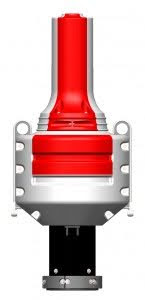
Fairway Buoy
Fairway buoys signal safe water. The are used to mark the middle of waterways, channel entrances and landfalls. As seen in the image above (click to expand), fairway buoys are marked with red and white vertical stripes. All of those stripes are of equal width.
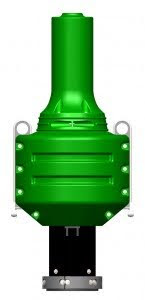
Port Hand Buoy
A port hand buoy marks the port (left) side of a channel when navigating upstream. It will be green in color and may come in a variety of sizes. If a light is attached, the lens will be green in color. The flash character will be determined by your local coast guard authority. If retroreflective tape is being used, it must be green as well.
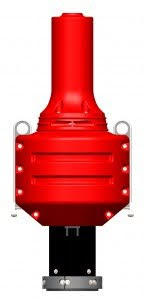
Starboard Hand Buoy
The right (starboard) side of a channel, travelling upstream, will be marked by starboard hand buoys. These are red in color, with a conical or red cone top. If the buoy has a lantern attached, the light will be red as will any retroreflective tape.
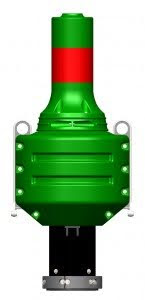
Port Junction Bifurcation Buoy
When navigating up a channel, a port junction bifurcation buoy will be used to determine the preferred or main channel for navigation. Mariners must navigate to the port (right) side of the buoy. The port junction bifurcation buoy will be green in color with a broad red brand displayed horizontally. Any retroreflective tape will be green as will be the lantern, if there is one. If no light is present, a topmark may be. That topmark will be a green cylinder.
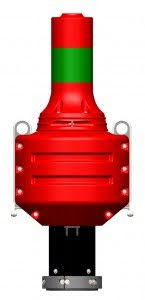
Starboard Hand Bifurcation Buoy
Complimenting the port junction bifurcation buoy, the starboard hand bifurcation buoy marks the preferred channel to take in the upstream direction. This time the preferred channel will be on the port (left) side of the buoy. If retroreflective material and a lantern are present, that material and lantern will both be red in color. If it has a topmark, the topmark should be a single red sphere.
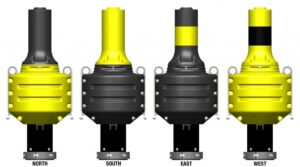
North, South, East and West Cardinal Buoys
Cardinal buoys mark the deepest or safest location of water, referencing the cardinal points on the compass. As you’ll see by the photo above, the north cardinal buoy is equal parts yellow and black, with the black portion of the buoy being on top. A south cardinal buoy is just the opposite with the black on the bottom. An east cardinal buoy will be primarily black with a thick horizontal yellow band while a west cardinal buoy is primarily yellow with a thick black horizontal band. If a light is present on a cardinal buoy, the lantern’s lens will be white. Topmarks would be configured as follows:
North Cardinal: Two black cones, both pointing up, one above the other.
South Cardinal: Two black cones, both pointing down, one above the other.
East Cardinal: Two black cones, one point up and one point down, one above the other.
West Cardinal: Two black cones, with their points touching, one above the other.
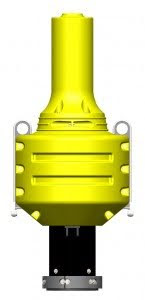
Cautionary Buoy
Cautionary buoys mark hazards to navigation such as aquaculture sites, race courses, underwater structures and more. They are completely yellow in color. A cautionary buoy will most often carry retroreflective tape and at times, an optional yellow topmark in the shape of an ‘X’.
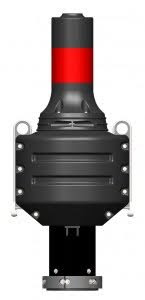
Isolated Danger Buoy
An isolated danger buoy will be moored above a hazard that has navigable water surrounding it. This includes wrecks and rock formations that aren’t visible on the surface of the water. It is primarily black in color with a large red horizontal band. If retroreflective tape is present, it will be white in color. If a marine lantern is attached, its lens will be white. If there is a topmark, it will be two black spheres, on top of each other.
The marks of the buoys above can be applied to buoys of any shape or size, as long as the shape or size is appropriate for the application and falls within the parameters of your local coast guard or authority. The photos in this article feature the Go Deep 1.5M HDPE Skirt Buoy. The isolated danger buoy in the header image is the Go Deep 1.2M CAN Buoy.
As a mariner, you may still have questions about navigation buoys. For more information on these buoy types and others, please contact us by filling out the form to the right.
